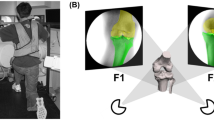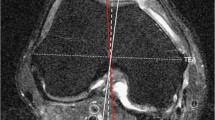Abstract
Purpose
It is a challenge to evaluate the maintenance of medial and lateral soft tissue balance in total knee arthroplasty (TKA). This study aimed to determine the “isoheight” points and the “isoheight” axis (IHA) that can measure constant medial/lateral condyle heights during flexion of the knee, and compare the IHA with two major anatomical axes, the transepicondylar axis (TEA) and the geometric center axis (GCA).
Methods
Twenty-two healthy human knees were imaged using a combined MRI and dual fluoroscopic imaging system while performing a single-legged lunge (0°–120°). The isoheight points of the medial and lateral femoral condyles were defined as the locations with the least amount of changes in heights during the knee flexion; an IHA is the line connecting the medial and lateral isoheight points. The measured changes of the condyle heights using the IHA were compared with those measured using the TEA and GCA.
Results
Overall, the IHA was posterior and distal to the TEA, and anterior to the GCA. The isoheight points measured condyle height changes within 1.2 ± 2.3 mm at the medial and 0.7 ± 3.3 mm at the lateral sides during the knee flexion. Between 0° and 45°, the condyle height changes measured using the GCA (medial: 3.0 ± 1.8 mm, lateral: 2.3 ± 2.0 mm) were significantly larger than those of the IHA and the TEA (p < 0.05). Between 90° and 120°, the changes of the condyle heights measured using the TEA (medial: 5.3 ± 1.8 mm, lateral: 3.3 ± 1.8 mm) were significantly larger than those of the IHA and GCA (p < 0.05).
Conclusion
There are isoheight points in the medial and lateral femoral condyles that can measure constant heights along the full range of knee flexion and could be used to formulate an “isoheight” axis (IHA) of the femur. The condyle height changes measured by the TEA and GCA were greater than the IHA measurements along the flexion path. These data could be used as a valuable reference to evaluate the condyle height changes after TKA surgeries and help achieve soft tissue balance and optimal knee kinematics along the flexion path.
Level of evidence
IV.



Similar content being viewed by others
References
Berger RA, Rubash HE, Seel MJ, Thompson WH, Crossett LS (1993) Determining the rotational alignment of the femoral component in total knee arthroplasty using the epicondylar axis. Clin Orthop Relat Res 286:40–47
Bonnin MP, Saffarini M, Bossard N, Dantony E, Victor J (2016) Morphometric analysis of the distal femur in total knee arthroplasty and native knees. Bone Jt J 98-B:49–57
Bourne RB, Chesworth BM, Davis AM, Mahomed NN, Charron KD (2010) Patient satisfaction after total knee arthroplasty: who is satisfied and who is not? Clin Orthop Relat Res 468:57–63
Churchill DL, Incavo SJ, Johnson CC, Beynnon BD (1998) The transepicondylar axis approximates the optimal flexion axis of the knee. Clin Orthop Relat Res 356:111–118
Colle F, Bignozzi S, Lopomo N, Zaffagnini S, Sun L, Marcacci M (2012) Knee functional flexion axis in osteoarthritic patients: comparison in vivo with transepicondylar axis using a navigation system. Knee Surg Sports Traumatol Arthrosc 20:552–558
Dimitriou D, Tsai TY, Park KK, Hosseini A, Kwon YM, Rubash HE et al (2016) Weight-bearing condyle motion of the knee before and after cruciate-retaining TKA: In-vivo surgical transepicondylar axis and geometric center axis analyses. J Biomech 49:1891–1898
Eckhoff D, Hogan C, DiMatteo L, Robinson M, Bach J (2007) Difference between the epicondylar and cylindrical axis of the knee. Clin Orthop Relat Res 461:238–244
Han HS, Kang SB (2018) Interactive effect of femoral posterior condylar offset and tibial posterior slope on knee flexion in posterior cruciate ligament-substituting total knee arthroplasty. Knee 25:335–340
Hess S, Moser LB, Amsler F, Behrend H, Hirschmann MT (2019) Highly variable coronal tibial and femoral alignment in osteoarthritic knees: a systematic review. Knee Surg Sports Traumatol Arthrosc 27:1368–1377
Hirschmann MT, Moser LB, Amsler F, Behrend H, Leclercq V, Hess S (2019) Phenotyping the knee in young non-osteoarthritic knees shows a wide distribution of femoral and tibial coronal alignment. Knee Surg Sports Traumatol Arthrosc 27:1385–1393
Hirschmann MT, Moser LB, Amsler F, Behrend H, Leclerq V, Hess S (2019) Functional knee phenotypes: a novel classification for phenotyping the coronal lower limb alignment based on the native alignment in young non-osteoarthritic patients. Knee Surg Sports Traumatol Arthrosc 27:1394–1402
Hoshino Y, Wang JH, Lorenz S, Fu FH, Tashman S (2012) The effect of distal femur bony morphology on in vivo knee translational and rotational kinematics. Knee Surg Sports Traumatol Arthrosc 20:1331–1338
Hosseini A, Qi W, Tsai TY, Liu Y, Rubash H, Li G (2015) In vivo length change patterns of the medial and lateral collateral ligaments along the flexion path of the knee. Knee Surg Sports Traumatol Arthrosc 23:3055–3061
Kim JH (2013) Effect of posterior femoral condylar offset and posterior tibial slope on maximal flexion angle of the knee in posterior cruciate ligament sacrificing total knee arthroplasty. Knee Surg Relat Res 25:54–59
Kim TK, Chang CB, Kang YG, Kim SJ, Seong SC (2009) Causes and predictors of patient's dissatisfaction after uncomplicated total knee arthroplasty. J Arthroplasty 24:263–271
Kozanek M, Hosseini A, Liu F, Van de Velde SK, Gill TJ, Rubash HE et al (2009) Tibiofemoral kinematics and condylar motion during the stance phase of gait. J Biomech 42:1877–1884
Li G, Van de Velde SK, Bingham JT (2008) Validation of a non-invasive fluoroscopic imaging technique for the measurement of dynamic knee joint motion. J Biomech 41:1616–1622
Lustig S, Lavoie F, Selmi TA, Servien E, Neyret P (2008) Relationship between the surgical epicondylar axis and the articular surface of the distal femur: an anatomic study. Knee Surg Sports Traumatol Arthrosc 16:674–682
Luyckx T, Vandenneucker H, Ing LS, Vereecke E, Ing AV, Victor J (2018) Raising the joint line in TKA is associated with mid-flexion laxity: a study in cadaver knees. Clin Orthop Relat Res 476:601–611
Marra MA, Strzelczak M, Heesterbeek PJC, van de Groes SAW, Janssen DW, Koopman B et al (2018) Anterior referencing of tibial slope in total knee arthroplasty considerably influences knee kinematics: a musculoskeletal simulation study. Knee Surg Sports Traumatol Arthrosc 26:1540–1548
Matsuda S, Miura H, Nagamine R, Mawatari T, Tokunaga M, Nabeyama R et al (2004) Anatomical analysis of the femoral condyle in normal and osteoarthritic knees. J Orthop Res 22:104–109
Minoda Y, Nakagawa S, Sugama R, Ikawa T, Noguchi T, Hirakawa M (2015) Midflexion laxity after implantation was influenced by the joint gap balance before implantation in TKA. J Arthroplasty 30:762–765
Mochizuki T, Sato T, Blaha JD, Tanifuji O, Kobayashi K, Yamagiwa H et al (2014) The clinical epicondylar axis is not the functional flexion axis of the human knee. J Orthop Sci 19:451–456
Most E, Axe J, Rubash H, Li G (2004) Sensitivity of the knee joint kinematics calculation to selection of flexion axes. J Biomech 37:1743–1748
Nam D, Nunley RM, Barrack RL (2014) Patient dissatisfaction following total knee replacement: a growing concern? Bone Jt J 96-B:96–100
Niki Y, Nagai K, Sassa T, Harato K, Suda Y (2017) Comparison between cylindrical axis-reference and articular surface-reference femoral bone cut for total knee arthroplasty. Knee Surg Sports Traumatol Arthrosc 25:3741–3746
Park IS, Ong A, Nam CH, Ahn NK, Ahn HS, Lee SC et al (2014) Transepicondylar axes for femoral component rotation might produce flexion asymmetry during total knee arthroplasty in knees with proximal tibia vara. Knee 21:369–373
Sharma A, Dennis DA, Zingde SM, Mahfouz MR, Komistek RD (2014) Femoral condylar contact points start and remain posterior in high flexing patients. J Arthroplasty 29:945–949
Stiehl JB, Abbott BD (1995) Morphology of the transepicondylar axis and its application in primary and revision total knee arthroplasty. J Arthroplasty 10:785–789
Stoddard JE, Deehan DJ, Bull AM, McCaskie AW, Amis AA (2013) The kinematics and stability of single-radius versus multi-radius femoral components related to mid-range instability after TKA. J Orthop Res 31:53–58
Watanabe T, Muneta T, Sekiya I, Banks SA (2013) Intraoperative joint gaps affect postoperative range of motion in TKAs with posterior-stabilized prostheses. Clin Orthop Relat Res 471:1326–1333
Watanabe T, Muneta T, Sekiya I, Banks SA (2015) Intraoperative joint gaps and mediolateral balance affect postoperative knee kinematics in posterior-stabilized total knee arthroplasty. Knee 22:527–534
Whiteside LA (2004) Ligament balancing in revision total knee arthroplasty. Clin Orthop Relat Res 423:178–185
Acknowledgements
We are grateful for the financial support of the National Institutes of Health (R01AR055612) and the Department of Orthopaedic Surgery at Newton-Wellesley Hospital.
Author information
Authors and Affiliations
Corresponding author
Ethics declarations
Conflict of interest
The authors declare that there is no conflict of interest.
Funding
This study was supported by a single funding: Funding source: National Institutes of Health, USA; Grant number: R01AR055612; Recipient: Guoan Li.
Ethical approval
This study was approved by our institutional review board (protocol number: 2003P000337/PHS).
Informed consent
Written consent was obtained from each subject prior to participating in this study.
Additional information
Publisher's Note
Springer Nature remains neutral with regard to jurisdictional claims in published maps and institutional affiliations.
Rights and permissions
About this article
Cite this article
Rao, Z., Zhou, C., Zhang, Q. et al. There are isoheight points that measure constant femoral condyle heights along the knee flexion path. Knee Surg Sports Traumatol Arthrosc 29, 600–607 (2021). https://doi.org/10.1007/s00167-020-05990-x
Received:
Accepted:
Published:
Issue Date:
DOI: https://doi.org/10.1007/s00167-020-05990-x




